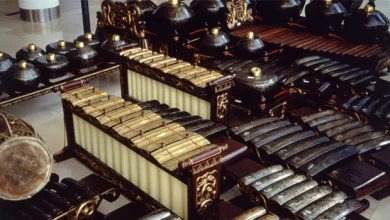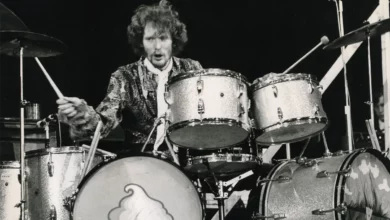
The first music history professor I ever had was consumed by Indian Classical music. While most of us were bleary-eyed and had barely just rolled into his 8 AM lecture, he’d excitedly tell us stories about his travels to the far east. In that class, I learned about the tabla, a mystifying instrument with dough on top of the drum heads.
Tabla is a membranophone that consists of two hand drums; one large and one small. The instrument is commonly heard in North Indian classical music, also called Hindustani classical music.
Years after Music History 1, I had the opportunity to interview a famous Hindustani violinist, Indradeep Ghosh, for a website. Within an hour video call, he offered many insights into Hindustani-style music, including tidbits of history and how this style’s rhythmic and melodic structure works.
He had worked with many a tabla player. So before we dive into the tabla’s history, listen to Indradeep Ghosh (violin) with Gourisankar Karmakar (tabla) here to get a taste of where all this history led to today.
When Was Tabla Invented?
Despite the tabla seeming like a relic of an ancient instrument, it is believed that the drums we see today weren’t created until the 1700s. The name “Tabla” is considered Arabic in origin since “tabl” means drum in Arabic.
Though the conception of the instrument is highly debated, we know that the tabla first came about sometime within the Mughal period. Many art forms flourished during this era because of the creative-minded emperors that had ruled sequentially. For example, the Taj Mahal was also built during this period.
Within the Mughal period, a new, softer type of music called Khayal arose. Khayal was highly influenced by Arabic and Persian cultures and alternates between rhythmic and melodic improv. It is thought that the tabla was explicitly created for Khayal.
Amir Khusru
Amir Khusru is often credited with creating the tabla, but there’s no hard evidence that this is the case. Khusru (Khusro) was a Sufi poet and musician from the 1200s. Some say that Khusru cut a double-headed drum called the mridangam in half, while others say that a court musician invented the drums around the early 1700s.
Interestingly, we don’t begin seeing pictographs of tabla until the mid-1700s, either, which suggests that Khusru didn’t make the tabla after all.
Tabla; More Murky Origins
Some believe the instrument came from a bordering country like Pakistan. Another origin theory is that drums came from Muslims who were immigrating to India. Others surmise that they are, more specifically, an offshoot of Islamic war drums. But no matter the exact birthplace of the instrument, we know that this pair of drums has Indian, Middle-Eastern, and Arabic influences.
The Pakhavaj
One main ancestral instrument to the tabla is the pakhavaj. The pakhavaj is a double-headed drum from India and the surrounding areas. The mridangam evolved from the pakhavaj, and the tabla evolved from the mridangam.

The earliest iterations of the pakhavaj were made from clay, but then the instrument came to be made from Many music historians say that the tabla is a pakhavaj that was cut in two pieces; the smaller piece became the treble drum (Daya), and the larger piece the bass drum (Baya).
The Mridangam
The mridangam is a drum traditionally used in Carnatic music, the music of Sothern India. But the tabla is new compared to the mridangam from which it descended. According to ipassio.com, early depictions of the instrument date back to around 200 BCE.
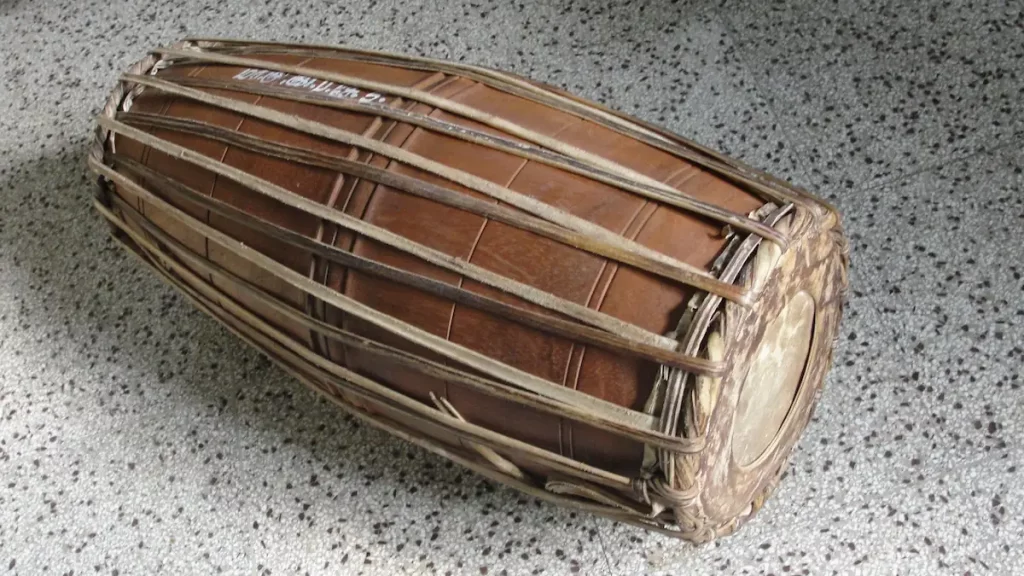
“Mridganam” means clay body due to how the instrument is made. The top of the mridangam and tabla is traditionally made from leather, such as buffalo and goat skin.
The tabla also likely gets its dough/Syahi from the mridangam. Dough on drum heads is unique to Indian drums. The mridangam and the pakhavaj are played sideways, whereas tabla are played flat.
Syahi: The Dough that Gives Tabla its Ring
Syahi is a black paste made from flour, water, and iron. The ancient mridangam is likely the first instrument to use syahi. The mridangam was said to be the god shiva’s favorite instrument. Syahi is applied in layers and is a very delicate process. As you can see in the picture, the dough has rings.
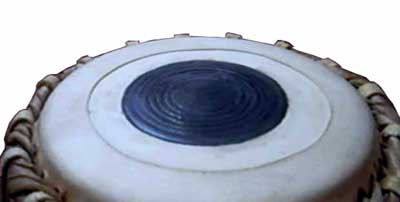
Side Note: Alexandrian Tabla
Another different type of drum that deserves an honorable mention is the Alexandrian tabla. This instrument is also known as the doumbek. The Alexandrian tabla is a Middle-Eastern goblet drum with Arabic origins. While it is often called a tabla, its history and sound differ from the Indian tablas in this article.
Use of Tabla in Dance Music
The tabla is often used to accompany dance music. This practice can be traced back to being used in upper-class dances for the royal court. Kathak is one such dance style in which tabla can be found and originally began as a way to tell stories.
The tabla is considered to be essential to Kathak, as the dancer and drummer both interact rhythmically. In addition, the dancer wears metal bells called ghungroos, which are percussion instruments—think of them as musical anklets. Check out an example of Kathak in the video here:
The Evolution of Tabla Notation
Tabla was learned by rote until the 1900s. Traditionally, the drums are taught by a guru (teacher) who leads the instrument using syllables called bols.
The instrument can make around 30 different bols or tonal syllables. Tabla syllables came from the earlier pakhajav, which used bols, a type of mnemonic syllable.
Eventually, these syllables were written down. Some tabla bols are played in unison (together) on both drums, while others are played separately.
As with most non-western drumming, tabla music isn’t standardized, but there are a handful of popular notations. The two most popular types of notation you will see are the Bhatkhande Notation System and the Paluskar Notation System. To understand the differences between the two notation systems, I’ll need to flesh it out a bit. Here are the four main aspects that are notated:
- Sum
- Taali
- Vibhaag
- Khaali
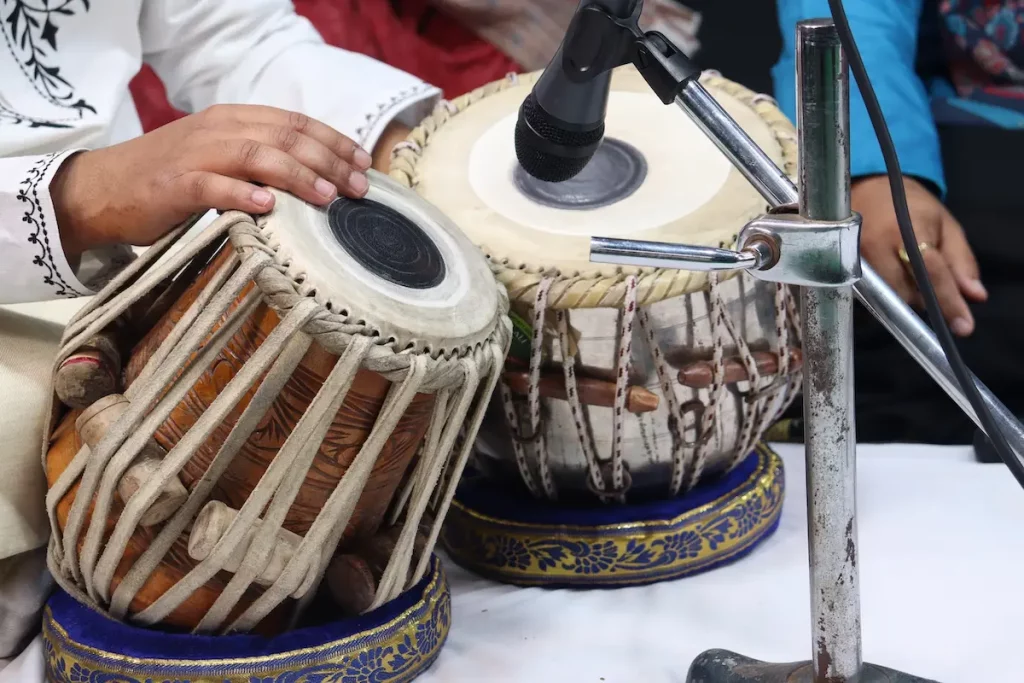
Sum is the first beat that starts the cycle. Taali and khaali are both types of strokes that are played. Taali means an open bass drum stroke, and khaali is a closed bass drum stroke. Lastly, vibhaag is a division of the main beat (matra).
The Paluskar Notation System was developed in the 20th century by Vishnu Digambar Paluskar. He used something called Sargam, a method for notating Indian classical music. The Palauskar system was the first modern system for notating tabla. The only downfall to this system is that it is particular about how long each note should be, So it takes quite a while to write down.
The following system, Bhatkhande’s, is the modern-day standard. While it still used Sargam, recording the mantras and divisions was much simpler and easier to understand.
Tabla Gharanas
A gharana is a “household” or, rather, a particular style of music. Tabla has gone through many gharanas in its relatively short history.
The first gharana that came about with Khayal is Qawwal Bacchon Ka Gharana, attributed to Amir Khusrau. This style has more leeway in the raga (melodic framework) than the styles before it.
Many key gharanas developed in the late 18th to 19th centuries, including Ajrara gharana, Benares gharana, and Lucknow gharana. Each new style can be refreshing to accompany dance or play the tabla.
Kirtan Singing
Kirtan (“Praise) is a type of Indian singing that’s been around since the 12 century in Southern India. As kirtan singing developed, it spread to Northern India, where new instruments were added, such as the tabla and even the guitar.
Tabla Legends
This wouldn’t be a complete article on the history of tabla if I didn’t tell at least one of the legends! One story says there was once a fiery competition between two pakhavaj players that resulted in the instrument being cut in half by a sword; thus, the pair of drums were made.
Another tale says the musician Khusru cut the drum in half to create a softer form of percussion for the new genre of Khayal music. There is also a mythical tabla tale involving the Hindu god of beginnings, Ganesh. It is said that Ganesh dropped his pakhavaj while playing it, and the tabla was created.
Changes Over the Years
Like many instruments, the tabla has evolved. While the dough and head remain the same, the bass drum (Bayan) of the tabla is now made of metal instead of clay.
The instrument has become incredibly popular. Over the past fifty-plus years, tabla can be heard in everything from the beat to Selena Gomez’s “Come and Get It” to The Beatles. What once started as a Hindustani instrument has become a popular hand percussion piece.
Conclusion
The history of most instruments is complex and muddy, but the history of the tabla captivates me the most. So before I head out, check out the work of local tabla player John Churchville in the modern guitar/tabla piece “September” here.
